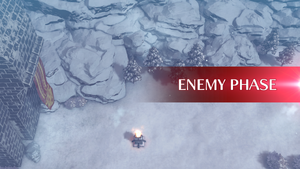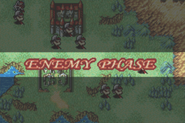
The Enemy Phase is the phase of a battle turn in which enemy units can perform actions, such as move, use an item, or attack.
Overview
The Enemy Phase is a phase of a turn in which the enemy force takes their actions. In turn order, it always takes place after the Player Phase. In battles where Ally Units are present, the Enemy Phase may instead follow the Ally Phase, as it does in Fire Emblem: Path of Radiance and Radiant Dawn. During the enemy phase, all enemy units will be given the opportunity to move and act, though enemies may not act if there are no Player Units, Ally Units, or Other Units within their attack range.
In Fire Emblem: Three Houses, which features battles in which three armies face each other, there are two Enemy Phases per turn, one for each faction not under the player's control. As they are not allied with each other, the enemies can attack each other as well as the player during their respective phases.
Strategy
Subjective: The following part of this article is based upon the editor's personal experiences and opinions, and therefore may not be applicable for all readers.
|
There are two main principles of the enemy phase that form enemy phase theory:
- During the enemy phase, all enemy units have the ability to move on their own and attack.
- Many enemy units can choose to attack the same opponent.
Therefore, the enemy phase allows the player to deal damage to many opponents in a single turn. It can be exploited by placing a single, powerful unit within range of large groups of weak enemies so that all of them can be dealt with at once. Such a strategy is vastly preferable to expending the turns of all of the player's units just to take out a single horde of enemies. This tactic is often called juggernauting, and it can sometimes be made possible for the course of an entire game by funneling EXP into a single player unit and "solo-ing" the game.
Since enemies tend to target opponents that cannot retaliate, units that can wield common 1-2 range weapons such as Javelins and Hand Axes are best suited for juggernauting, as they can counterattack against both units at melee range and units like archers and mages. Since sword-locked units usually only have access to a few, rare 1-2 weapons such as the Light Brand (which tends to deal low damage at 2-range), they are not often used for juggernauting. Archers, often being locked at 2-range, face the same issue.
The effectiveness of juggernauting varies between the series' entries; usually, it depends on enemy density, or the amount of enemies present in each chapter relative to their size. Games with high enemy densities tend to have low enemy quality, so juggernauting is a go-to strategy for clearing these games' chapters efficiently. For example, Fire Emblem: The Blazing Blade is considered to have a high enemy density and low enemy quality; therefore, enemy phase strategies are preferred in most of its chapters. Games that have a high enemy density and low enemy phase quality can sometimes be referred to as enemy phase-centric, or enemy phase-focused. The aforementioned sword-users and bow-users are at their worst in these situations.
Trivia
- In The Blazing Blade and The Sacred Stones, it is possible for the player to take control of the enemy units during the Enemy Phase by using the Enemy Control Glitch. This can be used to make enemy units trade/drop items, move away from seize points or important locations, and similar actions. Additionally, it is possible to make enemy units rescue other enemy units, or possibly even the player's own. However, if this glitch is used in The Blazing Blade to rescue Kishuna on any level where he warps out, the game will crash.


